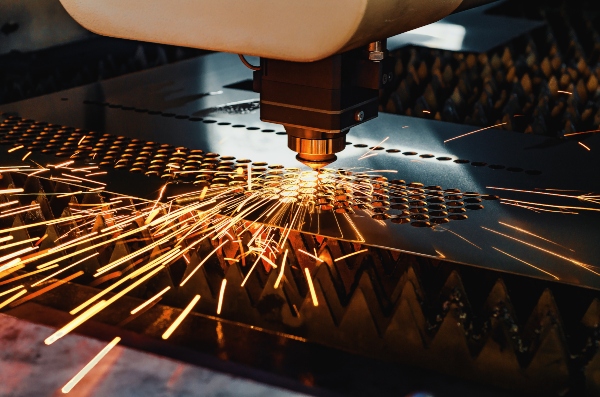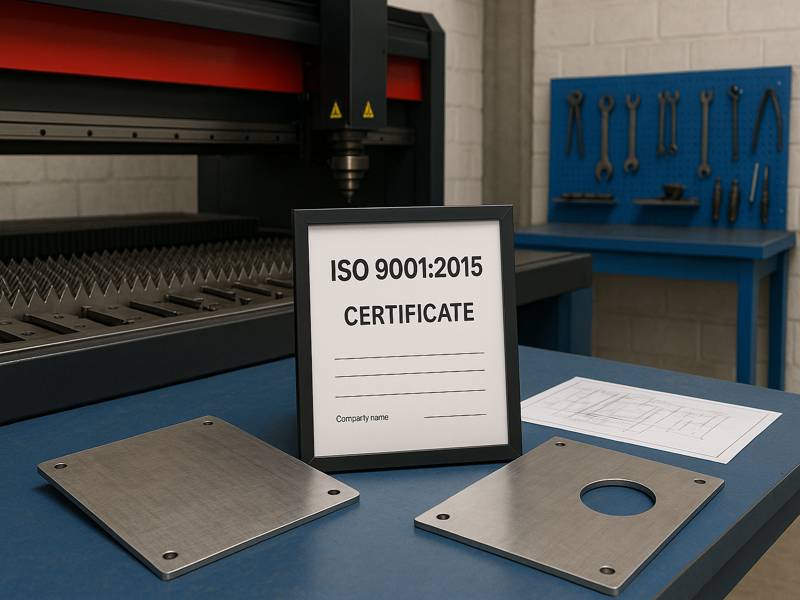In custom sheet metal fabrication, every bend, weld, and hole must meet exact tolerances. Customers order unique parts—from stainless enclosures and HVAC ducts to precision machine panels—expecting consistency and reliability. Achieving that level of repeatable quality across varied jobs is impossible without a system.
That system is ISO 9001:2015, the international benchmark for quality management. For fabricators, it’s not just paperwork—it’s a practical framework that keeps drawings accurate, parts consistent, and customers satisfied. This guide explains how ISO 9001:2015 applies specifically to custom sheet metal fabricators, the benefits it brings, and how to implement and maintain certification.
What Is ISO 9001:2015 and Why It Fits Fabrication
ISO 9001:2015 defines the requirements for a Quality Management System (QMS)—a structured way to plan, control, measure, and continually improve operations. The 2015 revision added risk-based thinking, process integration, and leadership accountability, all highly relevant to fabrication shops juggling diverse orders.
For fabricators, these principles directly support shop-floor reality:
- Customer focus: Meeting drawing tolerances, finish specs, and delivery promises.
- Leadership: Management sets measurable quality goals (e.g., ≤ 1 % rework).
- Engagement of people: Operators own first-piece inspections and tool maintenance.
- Process approach: Viewing quoting, nesting, bending, welding, coating, and packaging as linked processes.
- Improvement: Using data—scrap rates, on-time metrics—to drive better performance.

Why ISO 9001 Matters Specifically to Custom Sheet Metal Fabricators
Custom fabrication is unpredictable: one week you’re cutting thin aluminum covers, the next forming heavy-gauge steel brackets. ISO 9001 brings stability to variability by defining procedures that work for every order size.
Key reasons:
- Tight Tolerances Require Control – CNC lasers, brakes, and welders can only achieve repeatable accuracy if setup, calibration, and inspection steps are standardized.
- Traceability Matters – Aerospace, medical, and electronics clients demand full part traceability. ISO 9001 mandates record keeping for material certificates, operator ID, and inspection results.
- Complex Job Mix Needs Process Discipline – With dozens of part numbers daily, document control prevents the wrong revision from reaching the floor.
- Customer Confidence Wins Contracts – Many OEMs list ISO 9001 certification as a supplier requirement.
Ultimately, ISO 9001 transforms a reactive job shop into a predictable production partner.
Core ISO 9001 Requirements Tailored to Fabrication Shops
| Clause | Focus | Fabrication Application |
| 4. Context of the Organization | Understand internal & external issues | Identify risks like material shortages or operator skill gaps |
| 5. Leadership | Management commitment | Set weld-quality objectives, approve inspection resources |
| 6. Planning | Risk & opportunity | Analyze risks in prototype runs, tooling changes, or supplier delays |
| 7. Support | Resources, training, calibration | Maintain press-brake tooling logs and calibration records |
| 8. Operation | Controlled processes | SOPs for cutting, bending, welding, finishing, packaging |
| 9. Performance Evaluation | Data & audits | Track scrap rate, on-time delivery, and customer feedback |
| 10. Improvement | Corrective actions | Review nonconformance trends and implement root-cause fixes |
Each clause, when localized to fabrication realities, builds reliability from the quoting desk to final shipment.
How ISO 9001 Integrates with the Fabrication Workflow
Quoting & Engineering
- Drawings are reviewed for feasibility, tolerances, and materials.
- Controlled revision system ensures only the latest drawings reach production.
- Risk analysis identifies special processes (e.g., tight radii, exotic alloys).
Material Control
- Approved supplier list with mill-cert verification.
- Incoming inspection reports document sheet thickness, alloy grade, and flatness.
- FIFO storage prevents mix-ups between stainless and carbon steels.
Cutting and Punching
- Laser or turret programs verified by first-article inspection.
- Machine calibration records are kept per ISO 9001 clause 7.1.5.
- Deviations logged as nonconformances for corrective review.
Forming and Fabrication
- Press-brake operators follow documented bend-setup sheets.
- Fixtures and gauges are checked before use.
- Welding procedures (WPS/PQR) are controlled and traceable to operators.
Finishing and Assembly
- Powder-coating temperature charts are recorded to ensure adhesion quality.
- Assemblies were inspected for hardware torque, surface finish, and labeling accuracy.
Inspection & Delivery
- 100 % visual and sampling inspections follow control plans.
- Packaging specs stored with job routers for repeat orders.
- Delivery performance is analyzed monthly as part of the management review.
By mapping ISO requirements onto each fabrication phase, shops achieve full process visibility.
Benefits of Certification for Custom Fabricators
| Benefit | Practical Impact on Fabrication Business |
| Process Consistency | Standard work instructions minimize setup errors across shifts. |
| Reduced Rework & Scrap | Data-driven root-cause analysis lowers scrap rates. |
| Customer Retention | OEM clients trust certified partners for repeat projects. |
| Employee Accountability | Clear job descriptions tie performance to quality goals. |
| Competitive Edge | ISO logo differentiates bids for aerospace or defense work. |
| Regulatory Compliance | Simplifies traceability audits for RoHS, REACH, or ASME needs. |
In short, ISO 9001 strengthens both shop-floor discipline and market credibility.
Roadmap to ISO 9001 Certification for Fabrication Shops
| Step | Action | Fabrication Example |
| 1. Gap Analysis | Compare current practices with ISO clauses | Discover missing calibration or document-control steps |
| 2. Develop QMS Documentation | Write procedures for quoting, production, and inspection | Create job-router templates and NCR forms |
| 3. Train Personnel | Educate supervisors & operators | Run toolbox talks on quality objectives and part traceability |
| 4. Internal Audit | Evaluate system readiness | Audit laser-cutting and welding processes |
| 5. Certification Audit | Third-party audit | Auditor verifies records and shop-floor compliance |
| 6. Continuous Improvement | Ongoing data analysis | Monthly KPI reviews for scrap %, delivery %, and rework cost |
Implementation typically takes 4–8 months for mid-size job shops, depending on documentation maturity.
Overcoming Common Challenges in Fabrication Environments
Documentation Overload
Fabricators fear paperwork slowing production. Digital QMS software or cloud-based forms cut time while maintaining control.
Operator Buy-In
Hands-on technicians resist new procedures. Engage them by linking ISO tasks to visible results—less rework, safer setups, easier audits.
High Mix Low Volume Complexity
Each order differs, but ISO doesn’t demand identical processes—only controlled ones. Use modular job travelers that adapt to part type.
Supplier Variability
Material quality swings affect end results. Establish incoming-inspection criteria and preferred-vendor ratings under clause 8.4.
With the right mindset, ISO 9001 becomes a productivity enhancer rather than bureaucracy.
Real-World Case Study: From Job Shop Chaos to Controlled Quality
Company Profile: A 50-person custom fabrication shop in Illinois specializing in medical-device frames and electronic enclosures.
Before ISO:
- Frequent drawing mix-ups.
- 9 % rework rate.
- Customers demanded corrective-action reports monthly.
Implementation Highlights:
- Document-control software introduced; revision errors dropped to zero.
- First-piece inspection checklists standardized.
- Weekly cross-department meetings reviewed scrap causes.
Results After Certification:
| KPI | Before | After (12 months) |
| Rework Rate | 9 % | 1.8 % |
| On-Time Delivery | 82 % | 98 % |
| Customer Complaints | 7 / quarter | 1 / quarter |
ISO 9001 transformed the shop from reactive firefighting to proactive improvement—while boosting morale and client confidence.
ISO 9001 vs Other Standards in Metal Fabrication
| Standard | Scope | Relevance to Fabricators |
| ISO 9001 | Quality Management | Foundational; applicable to all fabrication processes |
| ISO 14001 | Environmental Management | Controls paint emissions, waste recycling |
| ISO 45001 | Health & Safety | Addresses welding fumes, noise, and ergonomics |
| AWS D1.1 / ASME IX | Welding Qualification | Technical process specs complementing ISO 9001 QMS |
| ISO 3834 | Weld Quality System | Integrates with ISO 9001 for certified welding shops |
Combining ISO 9001 with process-specific standards builds a robust, multi-layered compliance system.
Maintaining Certification in a Dynamic Job Shop
Certification lasts three years, but auditors expect continuous improvement.
Key practices:
- Internal Audits: Schedule quarterly by process area (cutting, welding, finishing).
- Management Review: Analyze metrics—scrap %, delivery %, customer returns.
- Corrective Actions: Investigate root causes using 5-Why or Fishbone tools.
- Training: Refresh operator certifications for welding, inspection, and safety.
- Supplier Scorecards: Evaluate suppliers based on responsiveness, quality, and delivery.
Typical Fabricator KPIs
| Metric | Target | Benefit |
| Scrap Rate | ≤ 2 % | Cost savings & material efficiency |
| On-Time Delivery | ≥ 95 % | Customer satisfaction |
| NCR Closure Time | ≤ 7 days | Rapid problem resolution |
| Employee Training Completion | 100 % | Skill retention & compliance |
By turning audits into learning opportunities, fabricators keep systems alive instead of static.
ISO 9001:2015 gives custom sheet metal fabricators a clear roadmap to master variability, ensure repeatable quality, and win higher-value clients. It standardizes the chaos of prototype and short-run production without crushing flexibility.
A certified QMS unites every department—from quoting to welding—under one mission: build the right part, the first time, every time.
For today’s metal fabricators, ISO 9001 is not a bureaucratic checkbox; it’s the blueprint for sustainable growth, lower costs, and customer loyalty in a precision-driven world.

